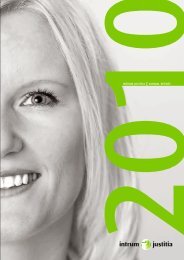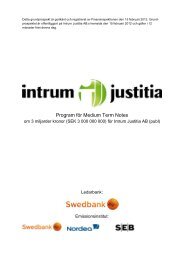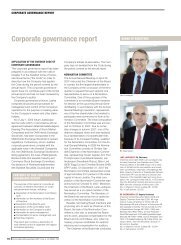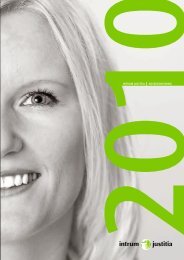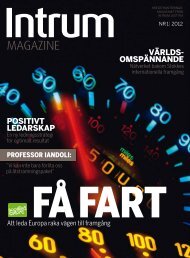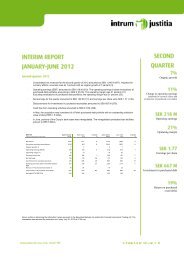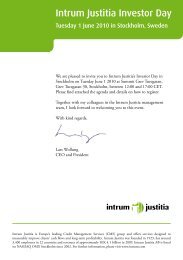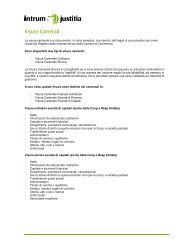Create successful ePaper yourself
Turn your PDF publications into a flip-book with our unique Google optimized e-Paper software.
NOTE 32 FINANCIAL INSTRUMENTS AND<br />
CONCENTRATION OF RISK<br />
Accounting and valuation principles<br />
For a description of accounting and valuation principles, refer to Note 1. As a rule,<br />
<strong>Intrum</strong> <strong>Justitia</strong> carries fi nancial instruments at fair value and recognizes changes in<br />
value through profi t or loss.<br />
Reported value and fair value of fi nancial instruments<br />
Shares in subsidiaries, associated companies and other companies<br />
The Parent Company’s holdings of shares in subsidiaries are recognized at cost.<br />
Holdings in the Group of other shares in associated companies are recognized<br />
according to the equity method. The holdings are not marked to market and fair<br />
values cannot be reliably determined.<br />
Shares in other companies refer to a four-percent holding in a company that<br />
is not publicly listed and where fair value cannot be determined without diffi culty,<br />
as well as several small shareholdings in listed companies where both the<br />
carrying amount and fair value are insignifi cant in relation to the Group’s total<br />
assets.<br />
Purchased debt<br />
Purchased debt is recognized at amortized cost according to an effective interest<br />
method. The Group restates the carrying amount by calculating the present value<br />
of estimated future cash fl ows at the receivables’ original effective interest rate.<br />
Adjustments are recognized through profi t or loss. With this valuation method, the<br />
carrying amount is the best estimate of the fair value of debt portfolios.<br />
Other receivables<br />
Other receivables have short maturities. Receivables and foreign currency are<br />
translated in the accounts at closing day rates. Consequently, the carrying amount<br />
corresponds to fair value.<br />
Liquid assets<br />
Liquid assets mainly consist of bank balances. Liquid assets in foreign currency<br />
are translated in the accounts at closing day rates. Consequently, the carrying<br />
amount corresponds to fair value.<br />
Liabilities to credit institutions<br />
The Parent Company’s and the Group’s loan liabilities carry market rate interest<br />
with short interest fi xing terms. Liabilities in foreign currency are translated in the<br />
accounts at closing day rates. Consequently, the carrying amount corresponds to<br />
fair value.<br />
Other liabilities<br />
The Parent Company’s and the Group’s other liabilities have short maturities.<br />
Liabilities in foreign currency are translated in the accounts at closing day rates.<br />
Consequently, the carrying amount corresponds to fair value.<br />
Derivatives<br />
The Parent Company and the Group hold forward exchange contracts to a limited<br />
extent. The contracts have short maturities, typically one or more months. All outstanding<br />
forward exchange contracts are restated at fair value in the accounts,<br />
with adjustments recognized through profi t or loss. The Group also holds interest<br />
rate cap contracts where both the carrying amount and fair value are nil.<br />
Principles of fi nancing and fi nancial risk management<br />
The fi nancial risks that arise in <strong>Intrum</strong> <strong>Justitia</strong>’s operations are limited. Thanks to<br />
a strong cash fl ow, combined with little need for investment and operating capital,<br />
external capital needs in operations are low.<br />
<strong>Intrum</strong> <strong>Justitia</strong>’s fi nancing and fi nancial risks are managed within the Group<br />
in accordance with the treasury policy established by the Board of Directors.<br />
The treasury policy contains rules for managing fi nancial activities, delegating<br />
responsibility, measuring and identifying fi nancial risks and limiting these risks.<br />
Internal and external fi nancial operations are concentrated in Group Treasury<br />
in Stockholm, which ensures economies of scale when pricing fi nancial transactions.<br />
Because Group Treasury can take advantage of temporary surpluses and<br />
defi cits in the Group’s various countries of operation, the Group’s total interest<br />
expense can be minimized.<br />
Exchange rate risk<br />
Exchange rate risk is the risk that fl uctuations in exchange rates will negatively<br />
affect the Group’s income statement, balance sheet and/or cash fl ows. Exchange<br />
rate risk can be divided into transaction exposure and translation exposure.<br />
Transaction exposure consists of the net of operating and fi nancial receipts and<br />
disbursements in different currencies. Translation exposure consists of the equity<br />
in foreign subsidiaries and associated companies in foreign currency and any<br />
goodwill in connection with acquisitions.<br />
Transaction exposure<br />
In each country, all revenues and the large part of operating expenses are denominated<br />
in local currencies, and thus currency fl uctuations have only a limited impact<br />
on the company’s operating earnings denominated in local currency. National<br />
operations seldom have receivables and liabilities in foreign currency. Revenues<br />
and expenses in national currency are thereby hedged in a natural way, which<br />
limits transaction exposure. The currency exposure that arises within the operating<br />
activities is limited to the extent it pertains to international collection operations.<br />
All major known currency fl ows are hedged on a continuous basis in the<br />
Group and the Parent Company through the use of forward exchange contracts.<br />
Outstanding forward exchange contracts as of December 31, 2005 in the Parent<br />
Company and the Group comprised the following currencies:<br />
Hedged<br />
Hedged<br />
Local currency<br />
amount, buy amount, sell<br />
CHF 2,370,210 13,792,179<br />
CZK 30,711,804 17,144<br />
DKK 11,966,250 36,591<br />
EEK 0 303,591<br />
EUR 7,242,168 41,941,929<br />
GBP 312,338 43,612,854<br />
HUF 0 635,488,286<br />
LVL 0 55,631<br />
NOK 709,546 49,318,387<br />
PLN 151,758 9,508,781<br />
Forward exchange contracts are classifi ed as fi nancial assets carried at fair value<br />
through profi t or loss (held for sale). The carrying amount as of December 31, 2005<br />
corresponds to fair value, SEK 1.0 M. During the year the changes in value of forward<br />
exchange contracts were recognized in the Group profi t or loss in the<br />
amount of SEK –39.2 M. The purpose of these forward exchange contracts has<br />
been to minimize exchange rate differences in the Parent Company attributable<br />
to receivables and liabilities in foreign currency. These exchange rate differences<br />
amounted to SEK 46.1 M during the year. The net effect on the income statement<br />
of exchange rate differences attributable to receivables and liabilities as well as<br />
forward exchange contracts is SEK 6.9 M.<br />
Translation exposure<br />
<strong>Intrum</strong> <strong>Justitia</strong> operates in 22 countries. Fluctuations in exchange rates affect<br />
the value of net assets in foreign currency. When the balance sheets for foreign<br />
subsidiaries are translated to SEK, balance sheet exposure arises because<br />
these balance sheets are expressed in currencies other than SEK. The results<br />
and fi nancial position of subsidiaries are reported in the relevant foreign currencies<br />
and later translated into SEK for inclusion in the consolidated fi nancial<br />
statements. Consequently, fl uctuations in the SEK exchange rate vis-à-vis these<br />
currencies affect the Group’s revenues and operating earnings, as well as equity<br />
and other items in its fi nancial statements. Fluctuations between SEK and other<br />
currencies can therefore have an unfavorable effect on earnings and fi nancial<br />
position as indicated in the consolidated fi nancial statements. This exposure is<br />
minimized through the limited need for equity locally and by fi nancing in local<br />
currency. As a result, net exposure in foreign assets is not hedged.<br />
Consolidated earnings in SEK are affected by exchange rate fl uctuations since<br />
earnings by subsidiaries are translated to SEK. Of the Group’s revenues in 2005,<br />
83 percent (84) was from operations outside Sweden. Exchange rate exposure<br />
does not affect the competitive situation faced by local subsidiaries, however,<br />
since they essentially operate in local currency. As a result, this exposure is not<br />
hedged.<br />
A ten-percent appreciation in exchange rates against SEK and each currency<br />
with the greatest exposure would have had the following effect on revenues in 2005:<br />
CHF, SEK +30 M; EUR, SEK +142 M; GBP, SEK +27 M, and NOK, SEK +11 M.<br />
57



